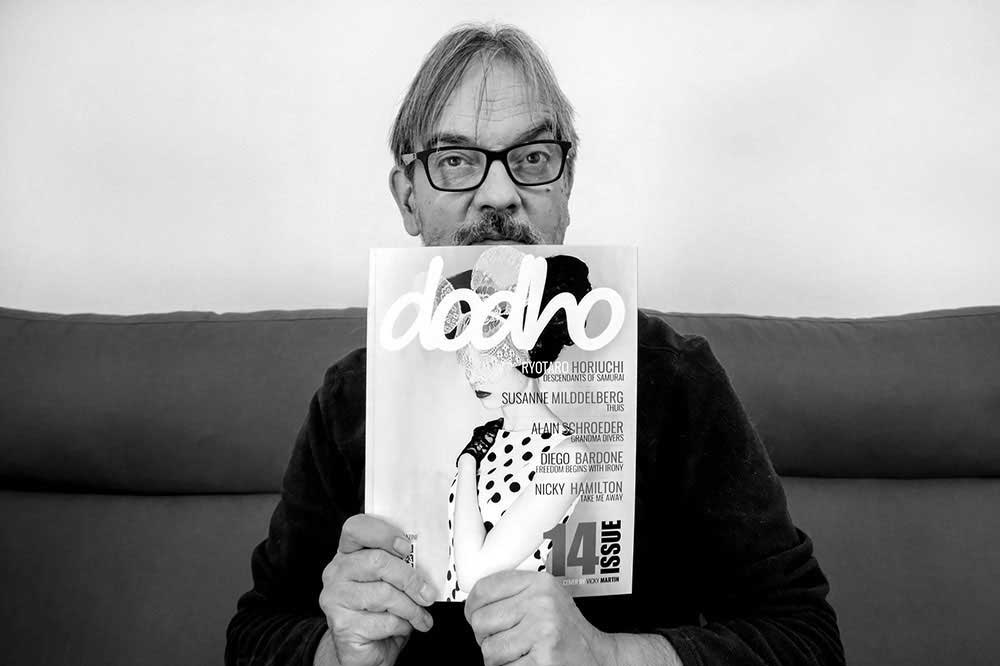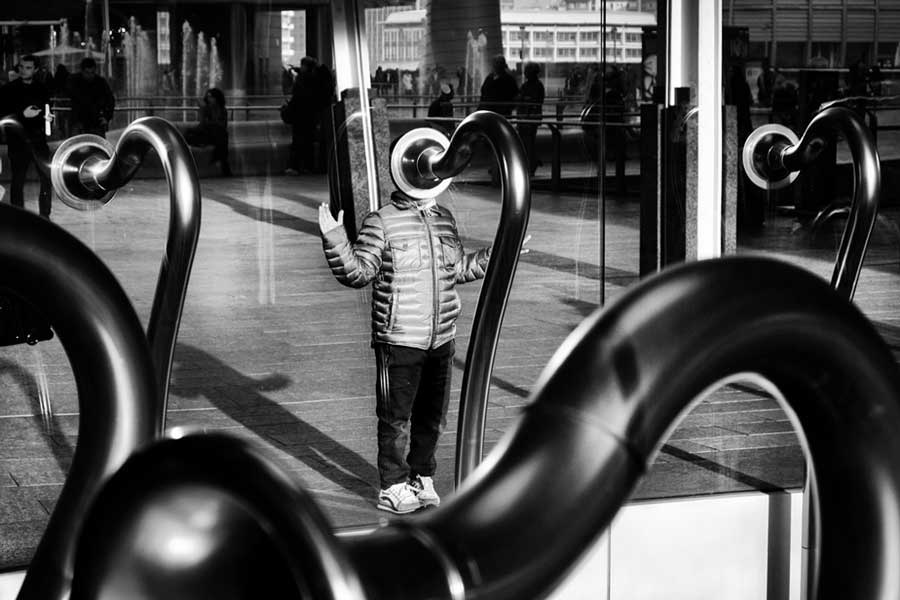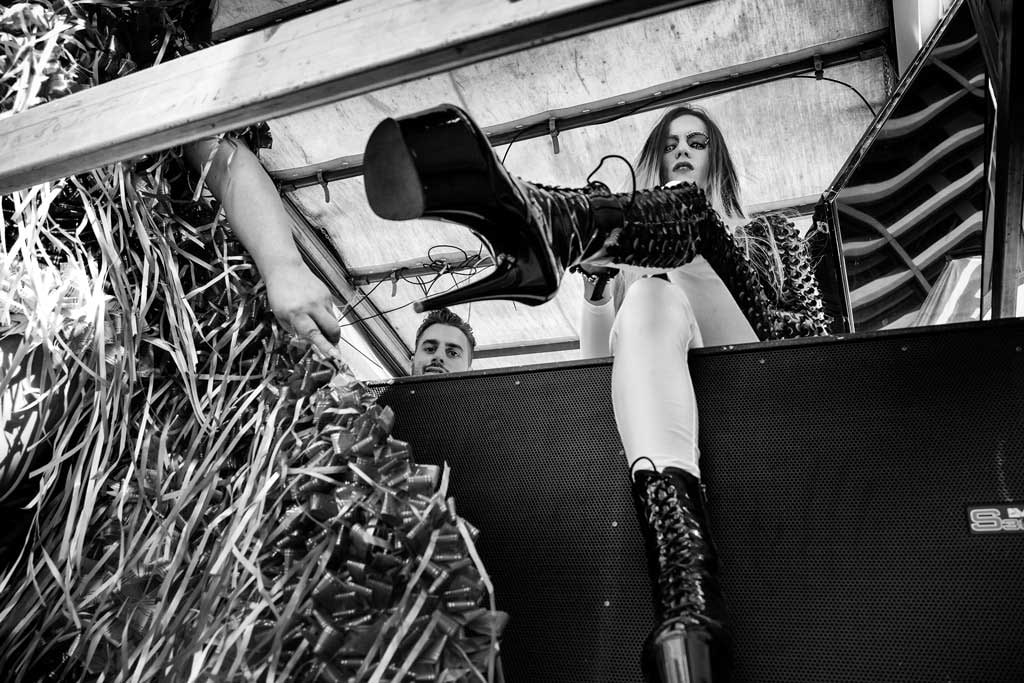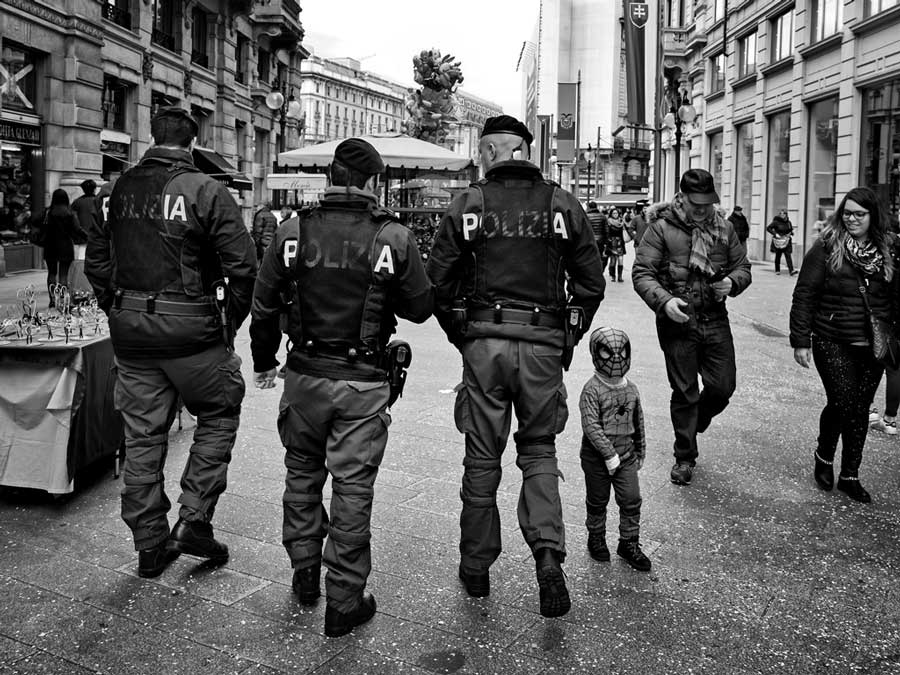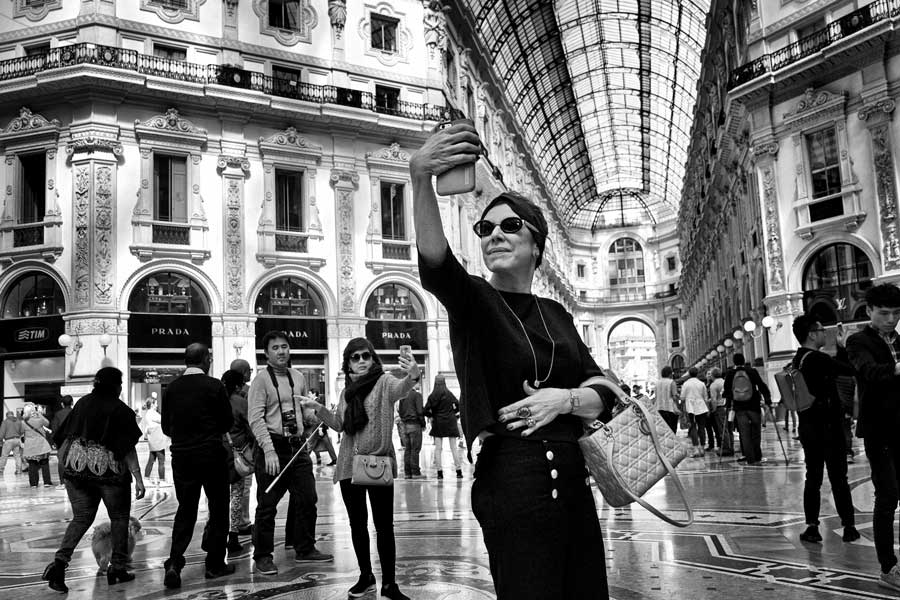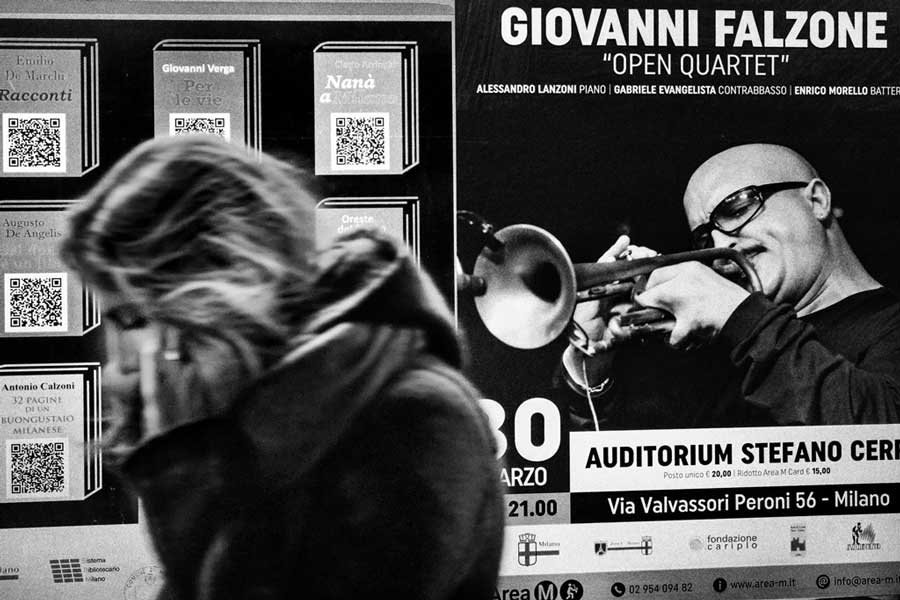Diego Bardone brings the timeless and classic quality to street photography. His visions connect to Franca Sozzani’s concept of lightness about life and style.
There is a genuine Italian touch in his works that makes him cool. He shows a society in a completely different manner, and he is a master at sequencing his street photo series. His works will for sure endure through time. [Official Website][Print Edition][Digital edition]
Your series Kiss me stupid and No Face both show clever motives for street photography series. I find them quite inspired and refreshing. How did you get to these choices? and how did you look for the repeated patterns to create these series? Tell me about the inspiration and the process of work for these two series.
First of all, thank you for this interview. Being a street photographer is more about how you are in everyday life rather than the photography itself. Said that, except for the Born to run series, I never go out looking for something specific. I let myself be carried away by the flow of everyday life, a non-paying spectator in the theater of life. I walk along the street for the pleasure of being there, feeling neither more nor less than one of the others. Probably our experience makes us look for certain subjects rather than others and this is how, in the end, photographic series come to life.
I would never go out with the express intent to shoot kissing people or those who are unrecognizable because I would be conditioned and I would lose many different opportunities. Inspiration? Simple, in my eyes there is the lesson of post-war french humanist, Bresson, Doisneau, Isis, Bout, Brassai, plus Erwitt, just to name a few. I adore their ironic, sentimental, and sometimes melancholic touch. We all made copies of what has already been done, our goal is to add that pinch of salt in order to make us recognizable at first glance if you know what I mean. The No Face series is a sort of sarcastic ode to the privacy law and its total anachronism. We are checked wherever we are, wherever we go, and then it is not clear how an innocent and honest photograph can harm someone.
With Rainbow People, I can see your style again. It’s classic and vintage. There is a common retro look in your photographs that makes them look old, like if they become part of human history. There is also a sense of dignity and respect in this work. How did you approach this series and the people portrayed?
I’m an old fashioned man…answered! lol! Jokes aside, I like what you said, I think my works are honest and surrounded by the old good style, well I try to do it, then I’m not the right one to say it. I shoot to remember and possibly not be forgotten and I always pay respect to my subjects. I never ask someone: ‘May I take a shot?’, I just do it and I like it if people look straight to my camera. “Everyone has so much history, so many faces, so much of everything, so much of nothing …” (G.Ferri), are the words that introduce the series, more or less the meaning is that we are all equal and any discrimination is the result of ignorance and fear. First of all, be part of pride is a must, then photographically speaking it is an opportunity. Not easy at all, because to get a good shot when you are faced with something extraordinary is very difficult. it is easy to fall into banality.
In this difficult time, in the covid era, how do you manage to create, and what’s more to find the pandemic as another motif to shoot? Tell me how this has become an inspiration to keep on working.
A very difficult time, to be honest during the lockdown I didn’t get any shot, I was not interested to portray empty spaces. The first time I went out with the camera I was with Francesco Tadini, a friend, and my mentor. I had no desire to take pictures, then he practically forced me to take one: three waiters standing alone in a bar, and then something clicked inside me and I started shooting again, strange but true. Photos, of course, are influenced by my state of mind which cannot be happy at all. There is a kind of emptiness and loss that is difficult to fill up. We shoot what we are, so the series is quite sad and melancholic and it contains photographs that are usually not my speed. I don’t think everything is going to be ok, as it was written on a lot of flags here in Italy. Anyway, we’d never lose hope for something better. We’ll see what happens…
Your works in Milan have a strong timeless style. There is some magic in each photograph. I would say that we can tell you know every city corner and that your connection to Milan is almost like a bond of blood. How does it feel to be an Italian street photographer born in Milan? Does your origin influence your works? and how would you define your relationship with Milan?
I agree with you it’s like a bond of blood. The knowledge of the area is essential. A Streeter must only and exclusively think about capturing photographs, he must feel at home while walking the streets of our cities and must not be influenced by anything. He just has to let himself be carried away and live in harmony with everything around him. Being shy or afraid of something around us doesn’t help at all. It’s a matter of passion, the more you feel it the more things works. The perfect recipe includes the idea, time, patience, dedication, good shoes, and talent as long as it takes. Milan is my personal theater, being born here is perfect: the city, constantly changing, offers endless opportunities. I love Milan, even if is a tough city, there is no social justice in this world.
Fashion is another source of inspiration for your works like I stated before, you share with Franca this hunt for coolness and striking images. What level of consciousness is there behind these choices and decisions? Are you aware of your fashion sense?
Tough question. My mother was a dressmaker, to watch her working was kinda magic for me. Maybe that’s why I’m attracted by the fashion world. To be honest, it’s a world that makes me suspicious as well, sometimes everything that goes around it seems so fake to me. I don’t have a precise idea, what I do know is that taking pictures outside, before and after, a fashion show, amuses me a lot. There are a lot of nice and strange characters that deserve to be shot. I try to portrait, in a cheerful way, a world that often seems to take itself too seriously. To desecrate with respect is what I seek.
With the series Freedom begins with irony, you represent street photography as the reflection of our behaviors. You recognize yourself in the spontaneity of the subjects you shoot, focusing on every day’s matters, and looking for the fun aspect of life. Tell me more about this intention and these images.
I’m the court jester, here to serve you…lol! There are so many bad things in this world, so when I hold a camera in my hands I want to make people smile, and why not, think a bit. Whether I succeed or not is not for me to say, but I try to do it with all the passion I have. Doisneau, Erwitt, and also Kalvar are my masters on this matter, but some film actors of the past have had a great influence on me, I’m referring to Buster Keaton, Stan Laurel and Oliver Hardy, Totò, and last but not least the genius among geniuses, Mr. Charlie Chaplin. Funny, disrespectful but at the same time disenchanted and melancholic, I adore them. My daily diary is a perennial tribute to Milan and to those who, as unconscious actors, I have the fate and chance to meet in my wandering the streets of my city. It is as if I’m observing myself in a sort of virtual mirror that finds its dimension in our everyday reality. We all have the same faces, the same joys, the same hopes: I am them, my wandering joy in images transferred to them. I would like to prove that simplicity is synonymous with beauty, I would like to show, as Doisneau used to say, a kind world, the world I love and that makes me somehow happy. That’s all, thanks a lot I really enjoyed answering you.
As we can read on Madonna’s t-shirt in her video for Papa don’t preach: Italians do it better. Thanks, Diego for your wit.
Seigar
Seigar is a passionate travel, street, social-documentary, conceptual, and pop visual artist based in Tenerife, Spain. He feels obsessed with the pop culture that he shows in his works. He has explored photography, video art, writing, and collage. He writes for some media. His main inspirations are traveling and people. His aim as an artist is to tell tales with his camera, creating a continuous storyline from his trips and encounters. He is a philologist and works as a secondary school teacher. He is a self-taught visual artist, though he has done a two years course in advanced photography and one in cinema and television. His most ambitious projects so far are his Plastic People and Tales of a City. He has participated in several international exhibitions, festivals, and cultural events. His works have been featured in numerous publications worldwide. His last interests are documenting identity and spreading the message of the Latin phrase: Carpe Diem. Recently, he received the Rafael Ramos García International Photography Award. He shares art and culture in his blog: Pop Sonality.



